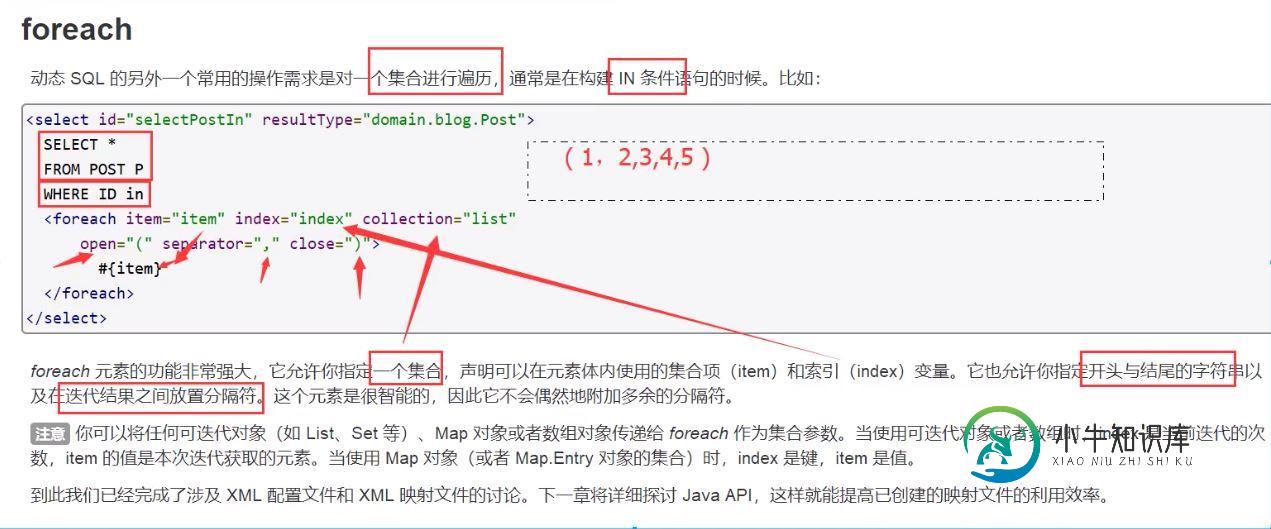MyBatis动态SQL实现配置过程解析
动态SQL
什么是动态SQL:
动态SQL就是根据不同的条件生成不同的SQL语句
- if
- choose(when,otherwise)
- trim(where,set)
- foreach
1、搭建环境
建表
CREATE TABLE `bolg`( `id` VARCHAR(50) NOT NULL COMMENT '博客id', `title` VARCHAR(100) not null comment '博客标题', `author` VARCHAR(30) not null comment '博客作者', `creat_time` datetime not null comment '创建时间', `views` int(30) not null comment '浏览量' )ENGINE=InnoDB DEFAULT CHARSET=utf8
创建一个基础工程
导包
编写配置文件
编写实体类
@Data
public class Blog {
private int id;
private String title;
private String author;
private Date creatTime;
private int views;
}
编写实体类对应的Mapper接口和Mapper.xm
2、IF
<select id="queryBlogIF" parameterType="map" resultType="com.rui.pojo.Blog">
select * from mybatis.bolg where 1=1
<if test="title != null">
and title = #{title}
</if>
<if test="author != null">
and author = #{author}
</if>
</select>
@Test
public void queryBlogIF(){
SqlSession sqlSession = MyBatisUtils.getSqlSession();
BlogMapper mapper = sqlSession.getMapper(BlogMapper.class);
HashMap map = new HashMap();
map.put("author","尹锐");
List<Blog> blogs = mapper.queryBlogIF(map);
for (Blog blog : blogs) {
System.out.println(blog);
}
sqlSession.close();
}
3、choose(when,otherwise)
<select id="queryBlogChoose" parameterType="map" resultType="com.rui.pojo.Blog">
select * from mybatis.bolg
<where>
<choose>
<when test="title != null">
title=#{title}
</when>
<when test="author!=null">
and author = #{author}
</when>
<otherwise>
and views = #{views}
</otherwise>
</choose>
</where>
</select>
4、trim(where,set)
select * from mybatis.bolg
<where>
<if test="title != null">
title = #{title}
</if>
<if test="author != null">
and author = #{author}
</if>
</where>
<update id="updateBlog" parameterType="map">
update mybatis.bolg
<set>
<if test="title != null">
title = #{title},
</if>
<if test="author != null">
author = #{author},
</if>
</set>
where id = #{id}
</update>
所谓的动态SQL,本质还是SQL语句,只是我们可以在SQL层面,去执行一些逻辑代码
5、Foreach
select * from user where 1=1 and
<foreach item="id" index="index" collection="ids"
open="(" separator="or" close=")">
#{id}
</foreach>
(id=1 or id=2 or id=3)

<!-- select * from mybatis.bolg where 1=1 and (id=1 or id=2 or id=3) 我们现在传递一个万能的map,这个map中可以存在一个map --> <select id="queryBlogForeach" parameterType="map" resultType="com.rui.pojo.Blog"> select * from mybatis.bolg <where> <foreach collection="ids" item="id" open="(" close=")" separator="or"> id = #{id} </foreach> </where> </select>
动态SQL就是在拼接SQL语句,我们只要保证SQL的正确性,按照SQL的格式,去排列组合就可以了
建议:
先在MySQL中写出完整的SQL,再对应的去修改成为我们的动态SQL
SQL片段
有的时候,我们可能会将一些公共的部分抽取处理,方便复用
使用SQL标签抽取公共的部分
<sql id="if-title-author">
<if test="title != null">
title = #{title}
</if>
<if test="author != null">
and author = #{author}
</if>
</sql>
在需要使用的地方使用Include标签引用即可
<select id="queryBlogIF" parameterType="map" resultType="com.rui.pojo.Blog">
select * from mybatis.bolg
<where>
<include refid="if-title-author"></include>
</where>
</select>
注意事项:
最好基于单表来定义SQL片段
不要存在where或者set标签,片段里尽量只有if就好了
以上就是本文的全部内容,希望对大家的学习有所帮助,也希望大家多多支持小牛知识库。
-
本文向大家介绍Mybatis动态SQL实例详解,包括了Mybatis动态SQL实例详解的使用技巧和注意事项,需要的朋友参考一下 动态SQL 什么是动态SQL? MyBatis的官方文档中是这样介绍的? 动态 SQL 是 MyBatis 的强大特性之一。如果你使用过 JDBC 或其它类似的框架,你应该能理解根据不同条件拼接 SQL 语句有多痛苦,例如拼接时要确保不能忘记添加必要的空格,还要注意去掉列
-
本文向大家介绍MyBatis实现动态SQL的实现方法,包括了MyBatis实现动态SQL的实现方法的使用技巧和注意事项,需要的朋友参考一下 MyBatis 最强大的特性之一就是它的动态语句功能。如果您以前有使用JDBC或者类似框架的 经历,您就会明白把SQL语句条件连接在一起是多么的痛苦,要确保不能忘记空格或者不要在 columns列后面省略一个逗号等。动态语句能够完全解决掉这些痛苦。 尽管与动
-
本文向大家介绍详解Mybatis动态sql,包括了详解Mybatis动态sql的使用技巧和注意事项,需要的朋友参考一下 1.什么是mybatis动态sql 看到动态,我们就应该想到,这是一个可以变化的sql语句 MyBatis的动态SQL是基于OGNL表达式的,它可以帮助我们方便的在SQL语句中实现某些逻辑 2.mybatis动态sql使用前准备 a.数据库表 b.创建类 3.使用mybatis动
-
动态 SQL 是 MyBatis 的强大特性之一。在 JDBC 或其它类似的框架中,开发人员通常需要手动拼接 SQL 语句。根据不同的条件拼接 SQL 语句是一件极其痛苦的工作。例如,拼接时要确保添加了必要的空格,还要注意去掉列表最后一个列名的逗号。而动态 SQL 恰好解决了这一问题,可以根据场景动态的构建查询。 动态 SQL 只有几个基本元素,与 JSTL 或 XML 文本处理器相似,十分简单明
-
本文向大家介绍Mybatis4 之Mybatis动态sql的实现代码,包括了Mybatis4 之Mybatis动态sql的实现代码的使用技巧和注意事项,需要的朋友参考一下 1.什么是动态SQL 传统的使用JDBC的方法,相信大家在组合复杂的的SQL语句的时候,需要去拼接,稍不注意哪怕少了个空格,都会导致错误。Mybatis的动态SQL功能正是为了解决这种问题, 其通过 if, choose, wh
-
本文向大家介绍mybatis的动态sql详解(精),包括了mybatis的动态sql详解(精)的使用技巧和注意事项,需要的朋友参考一下 MyBatis 的一个强大的特性之一通常是它的动态 SQL 能力。如果你有使用 JDBC 或其他 相似框架的经验,你就明白条件地串联 SQL 字符串在一起是多么的痛苦,确保不能忘了空 格或在列表的最后省略逗号。动态 SQL 可以彻底处理这种痛苦。 通常使用动态SQ

